Chelsea’s £97m summer investment in Romelu Lukaku was touted as the ‘final piece in the jigsaw’ to catapult Thomas Tuchel’s side towards a first league title in half a decade. But seven months into the season, the Belgian justifiably finds himself on the periphery of the Blues’ starting XI, exemplified by Tuchel’s decision to start Kai Havertz in last weekend’s Carabao Cup final defeat to Liverpool. Both Havertz and Lukaku, on paper, assume the same role of spearheading a front three in this Chelsea side. But their profiles couldn’t be less similar; the mercuriality and elegance of Havertz versus the brute strength and bundling power of Lukaku.
The broader elements of Lukaku’s struggles coincide with a distinguishable trend in the Premier League – out of the 23 top scorers in the division this season, only six are recognised as strikers. That figure, if compared to the 2011/12 season ten years ago, rises to 18 – an era characterised by the likes of Robin van Persie, Wayne Rooney, Sergio Aguero and Didier Drogba. This fluctuation consequently raises a viable angle of examination – is the role of the ‘traditional’ number 9 in elite-level football gradually being redefined?
The following analysis assesses the tactical elements of why the more versatile Havertz appears to have flourished in Chelsea’s recent fixtures, exploring the demands and responsibilities of modern-day strikers at the elite level.
Fluidity in possession
Despite the agonising manner of last Sunday’s loss, Chelsea have certainly recaptured some of the principles that characterised their epic Champions League conquest last season. The only notable variable that has changed in this transition is the selection of the starting striker. What was somewhat ignored in the aforementioned ‘final piece in the jigsaw’ analogy is that Lukaku’s profile is much harder to fit into a flexible and modern, pressing team than some of his current teammates, and his signing has arguably sobered Chelsea’s development.
On the contrary, Havertz seems to perfectly embody the attacking fluidity and mobility that caused both Liverpool and Lille copious defensive issues. The German first displaced Lukaku in last midweek’s routine 2-0 victory over Lille in the Champions League at Stamford Bridge, where Chelsea reverted to a more familiar 3-4-3 starting formation. Whilst it was not a vintage performance, there was notably more creation of superiority between the lines of pressure through rehearsed movements and rotation amongst the front three.
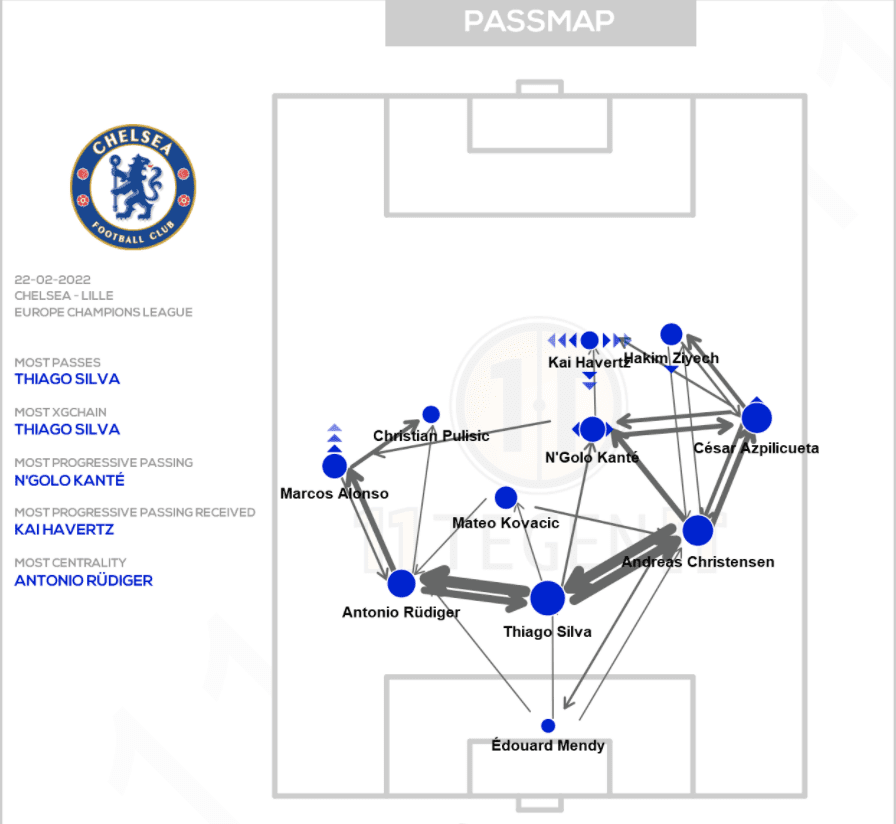
Whereas Chelsea’s wingbacks maintained width to stretch the opposition laterally, the narrower front three were tasked with exhibiting positional fluidity to create space vertically. It’s a system that flourishes if implemented with a degree of tactical flexibility.
In an otherwise quite flat and rigid formation, the creation of wide overloads to shift the opposition block and devise space on the opposite flank represented a key component to breaking down Lille’s man-orientated marking system. Chelsea managed to achieve this feat in the first forty seconds, with Havertz at the center of the move.
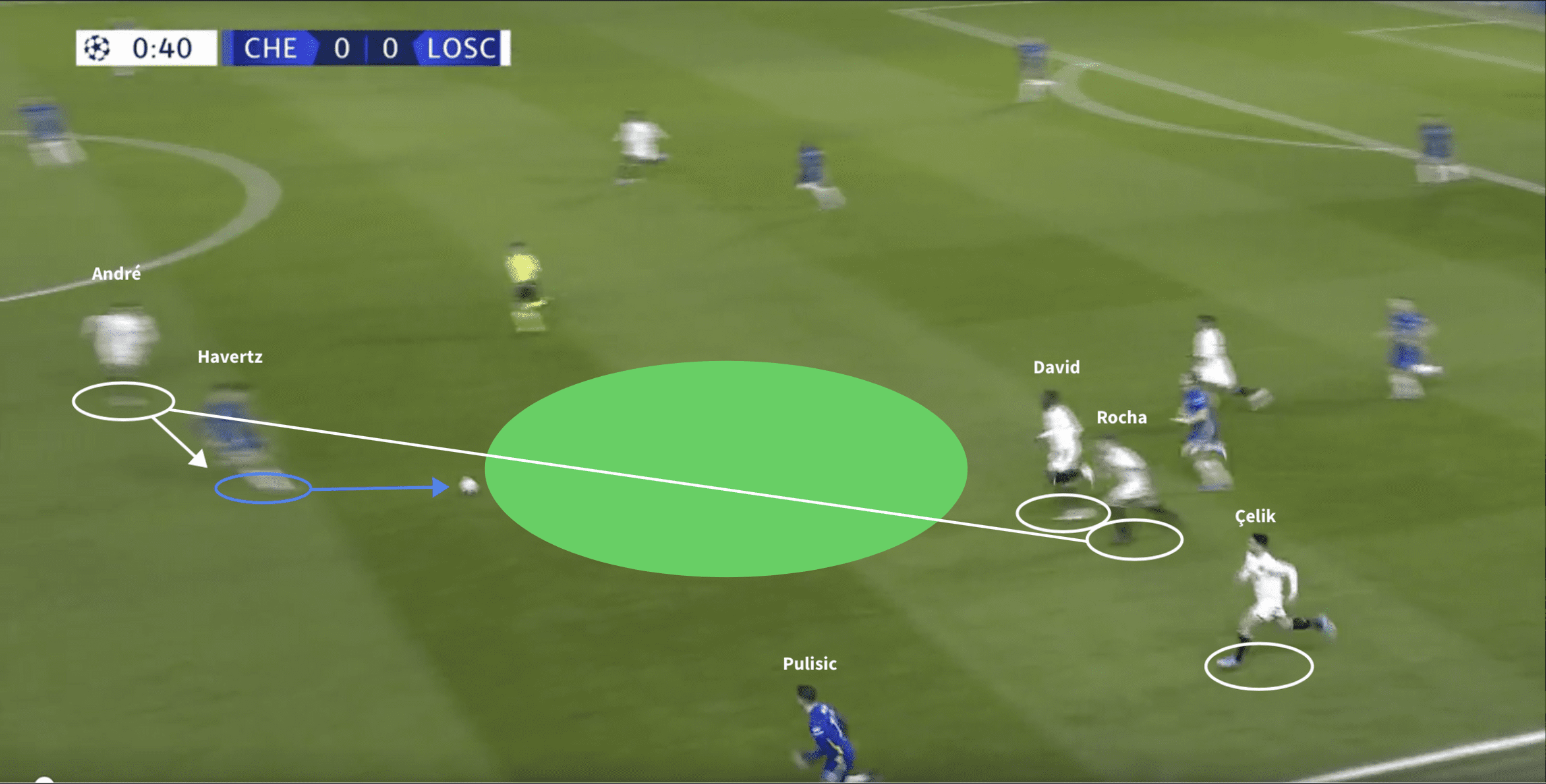
Here Havertz drops deep between the lines to receive the ball in space, creating a passing option to transcend the first line of pressure and produce great disparity between the midfield pivot of André and Rocha, isolating the deeper lying of the two. As right back Çelik is not goal side of Pulisic, Havertz is given an easy lateral option to circulate possession.
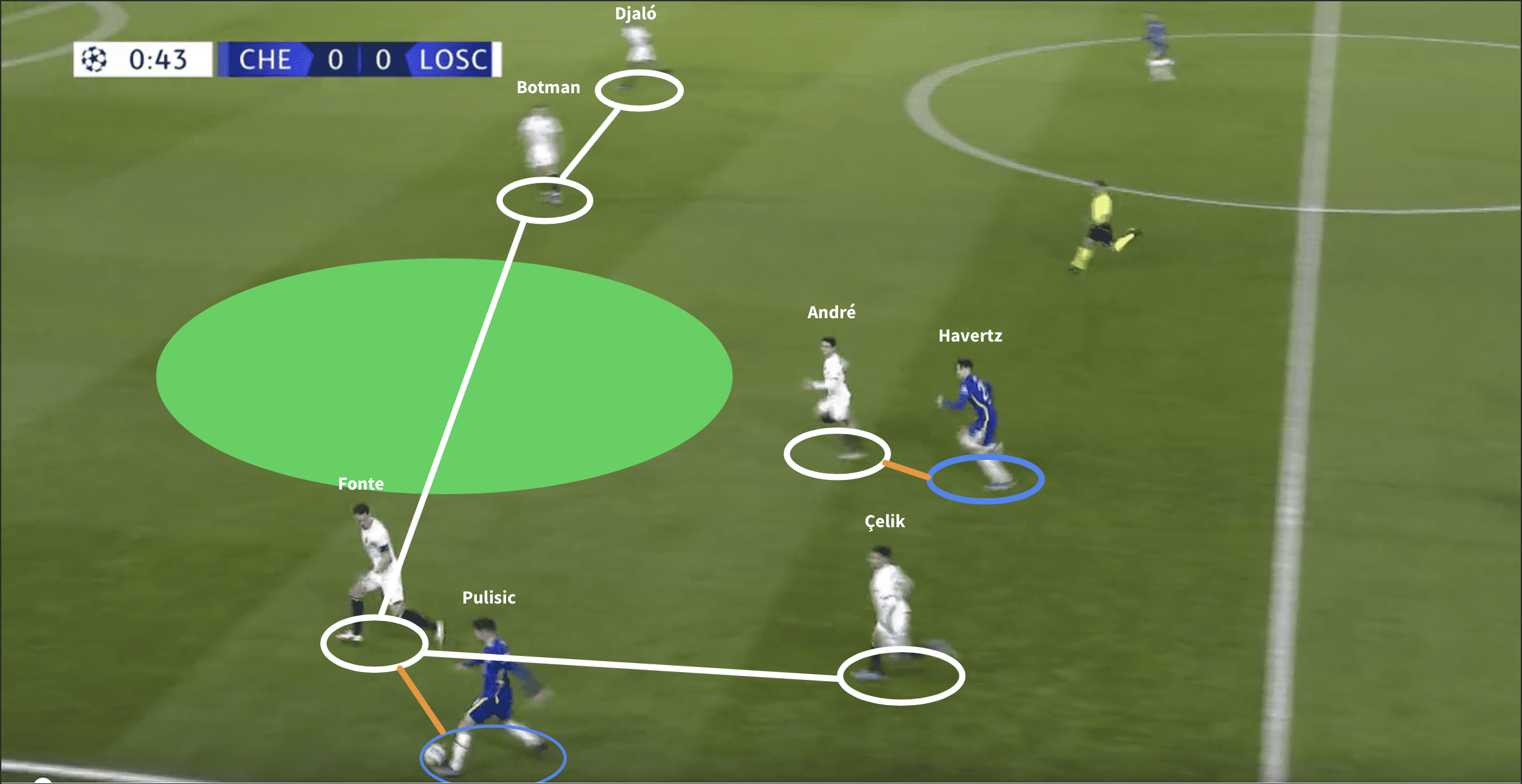
Çelik’s positioning means Fonte needs to come wide to close down Pulisic, creating a large gap between the two center-backs. Havertz continues his off-ball movement by looking to pierce this gap, facilitating a 2v2 and potential qualitative superiority.
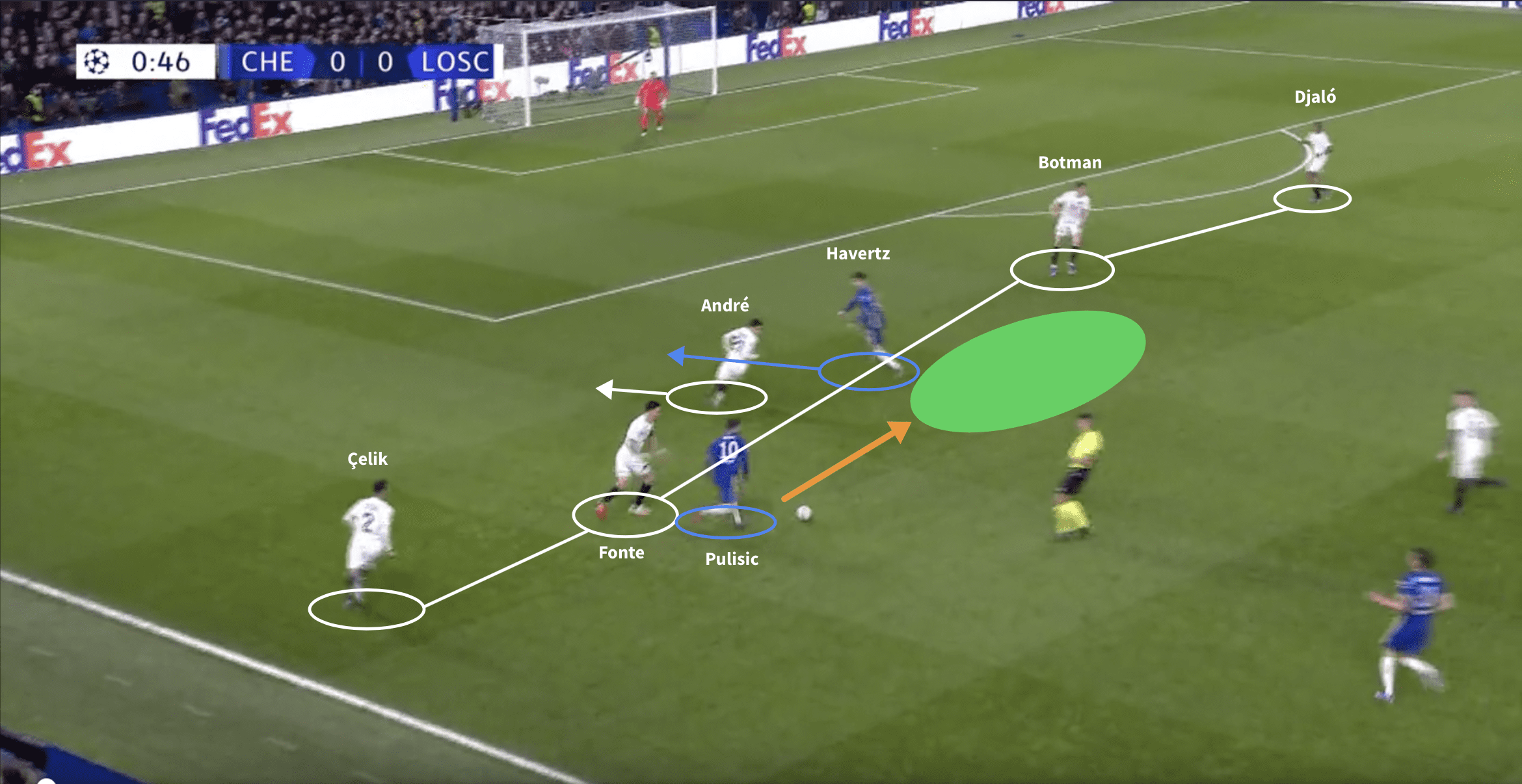
Pulisic beats his man (Fonte) and drives inside; Havertz therefore adjusts his run even wider to draw André, acting as a makeshift center-back, diagonally to the left. This creates more space for Pulisic to dribble into and pick a pass, now in a dangerous area.
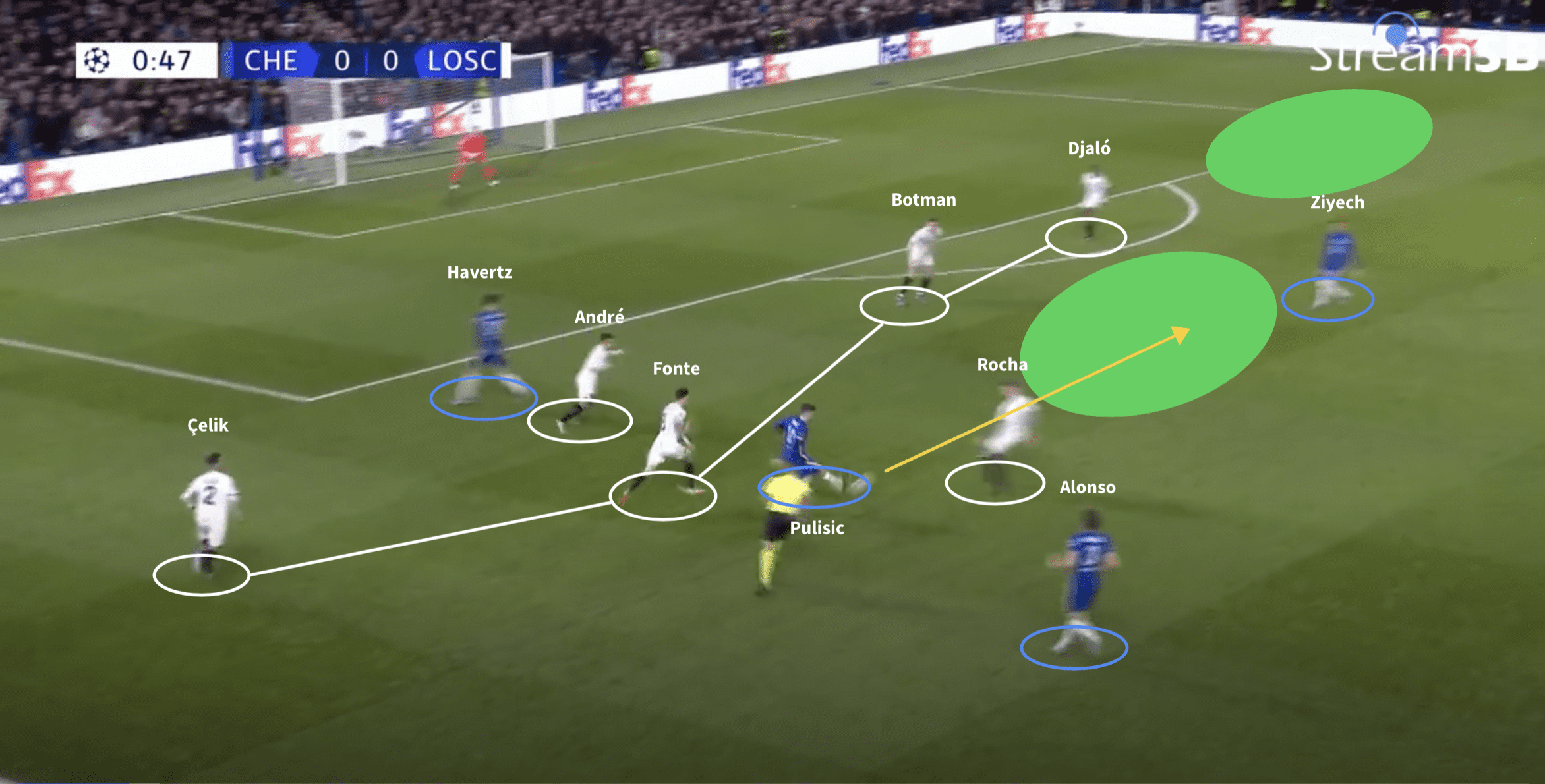
Havertz’s movement renders André unable to engage with the onrushing Pulisic, allowing an easy pass to Ziyech in the assist zone. A potential overload on the right-hand side is crafted to target Djaló, who is having to be dragged centrally to cover the exposed back four.
The ability to invade and dominate space constitutes a fundamental principle to controlling sub-phases in the game; Havertz exemplifies this by being able to drop deep into his own half and draw defensive players out of position, assisting in the creation of space in more potent positions on the pitch.
This is a responsibility not normally associated with an archetypal number 9 such as Lukaku, who typically would have planting himself on the last defender as a higher progressive option when the move started.
Assistance in asymmetrical rotations
Another key technical quality Havertz can bring to this Chelsea side is the ease with which he contributes to positionally rotating the offensive structure; an effective method that takes advantage of man-orientated marking.
Crucially, this requires players with high awareness to rearrange themselves into a more threatening structure, aiming to position players in more progressive areas in the manufactured space. Chelsea were likewise effectively able to fashion these patterns early in the same fixture.
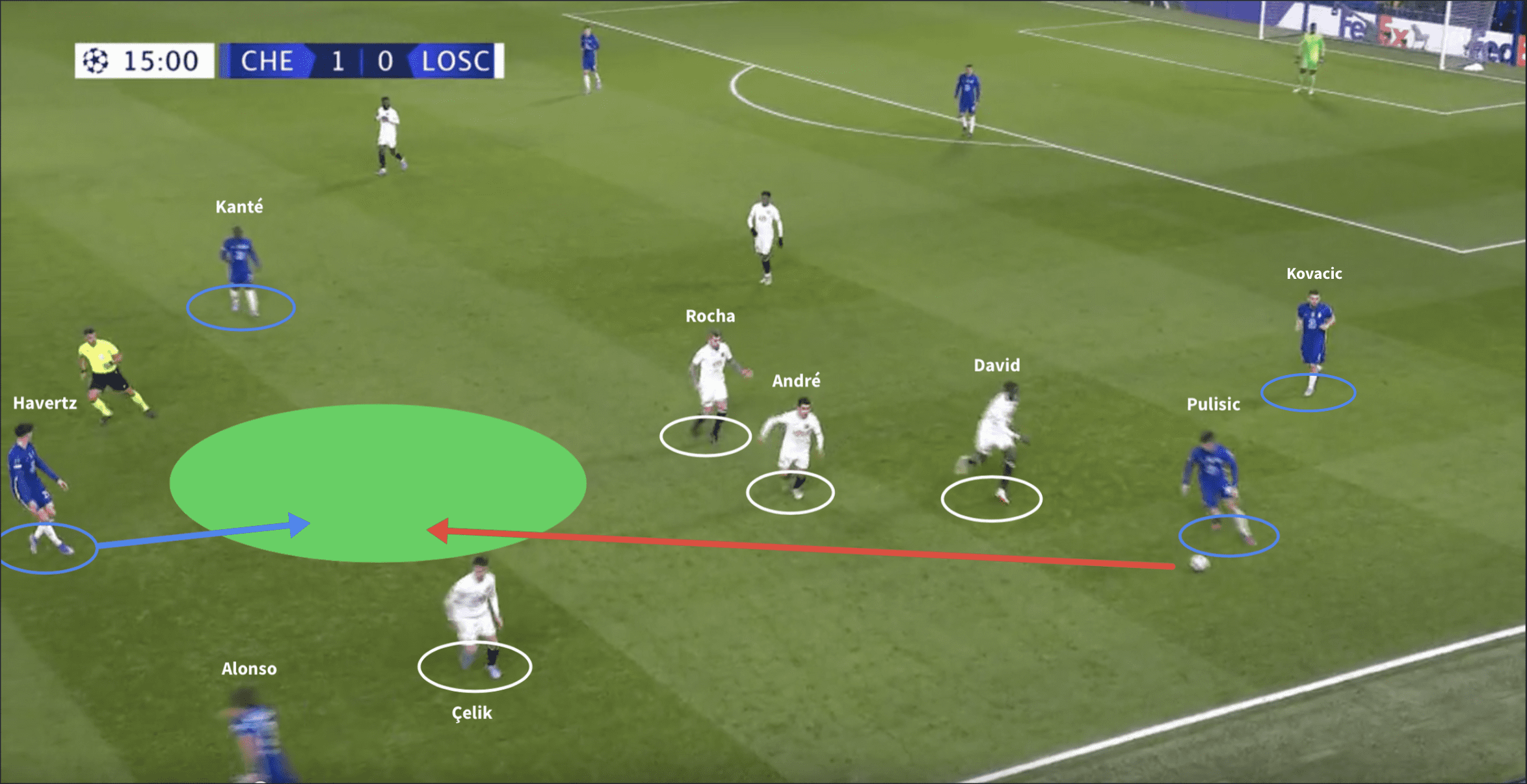
Here, Pulisic and Alonso have swapped roles and the American is under pressure from a high Lille block. Havertz is attentive to this development and therefore drops deep again to provide a passing option between the lines, assuming a midfield role and manipulating the team structure.
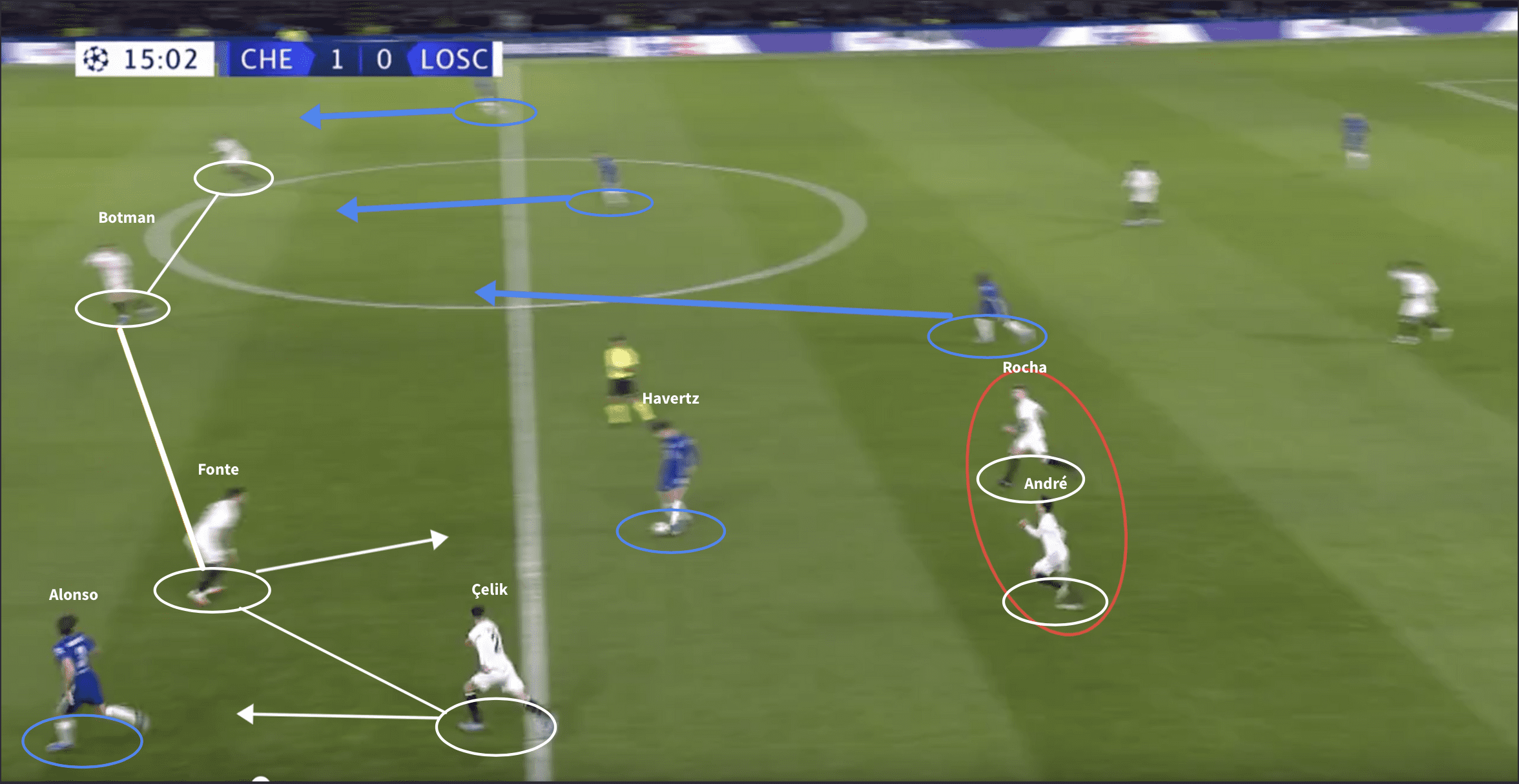
Havertz has time to turn, in total command of the space he has fashioned. The midfield pivot of Rocha and André are again badly exposed. Fonte is therefore unsure whether to engage with Havertz or track the movement of Alonso, whose wide third-man run is the by-product of an effective rotation with Pulisic. Notice the consequential disparity between the two center-backs.
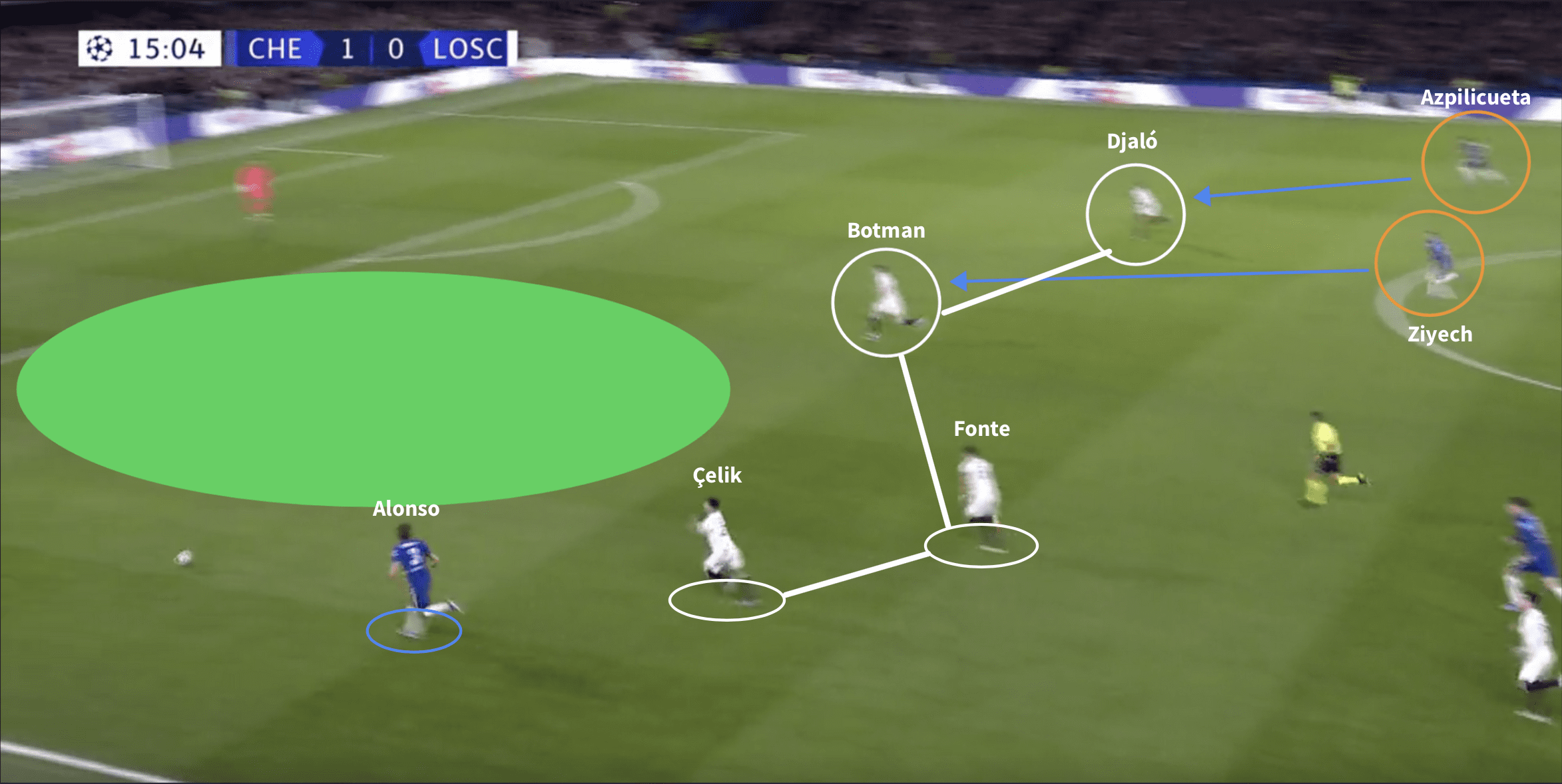
Havertz has time to pick an easy progressive pass to the onrushing Alonso, who has enormous space to run into. Fonte is caught flat-footed attempting to engage with Havertz’s positioning and is having to desperately make up ground. There is a potential 2v2 in the area if the cross is timed correctly.
Havertz therefore displays astute awareness to the repositioning of his side in possession; his contribution to assisting with the build-up play manipulates Chelsea’s wide structure and facilitates a strong progressive connection with Alonso. Subsequently, Lille’s defensive structure is vertically dragged out and exposed.
By exhibiting this positional fluidity, Chelsea were able to discover the connection between players that best facilitated progression through the lines. The role of Havertz as the striker therefore demands tactical cognizance and attentiveness.
Contrastingly, if bound by positional inflexibility, which arguably characterises a ‘target-man’ profile such as Romelu Lukaku, this restricts the freedom to interchange between positions and roles, and such rotations do not occur as frequently.
Ability to progressively carry
What also characterises Havertz’s influence in sub-phases, particularly following transitions, is his ability to carry and progress the ball into threatening areas. If we assume that a key feature of the false 9 role incorporates dropping deep to receive possession, it naturally follows that the player in question will have more distance to cover between himself and the opposition goal, so being able to effectively dribble and transfer the ball is crucial.
To illustrate, the figure below examines Havertz’s progressive metrics in the past 12 months:
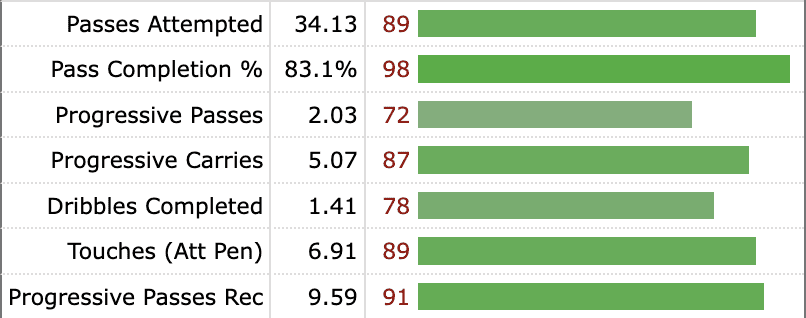
Most relevantly, Havertz’s average of 5.07 progressive carries and 1.41 completed dribbles per 90 places him in the top 13th and 22nd percentile of other strikers in Europe.
To compare, the figure below illustrates Romelu Lukaku’s progressive metrics in the same parameters:
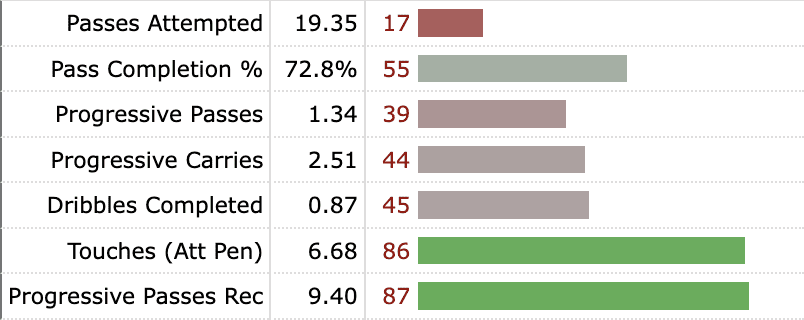
The Belgian’s average of 2.51 progressive carries and 0.87 completed dribbles per 90 places him in the bottom 44th and 45th percentile, representing a far inferior output to Havertz. In fact, there is not a single metric here that Lukaku outperforms Havertz in, even in progressive passes received and touches in the attacking penalty area; traits that one would normally associate with Lukaku’s style of play.
The implications of this are that Havertz’s inclusion offers Chelsea, upon establishing numerical superiority between the lines of pressure, the ability to progress the ball much more effectively and potently. They were thus able to achieve this more frequently against Jürgen Klopp’s formidable Liverpool side.
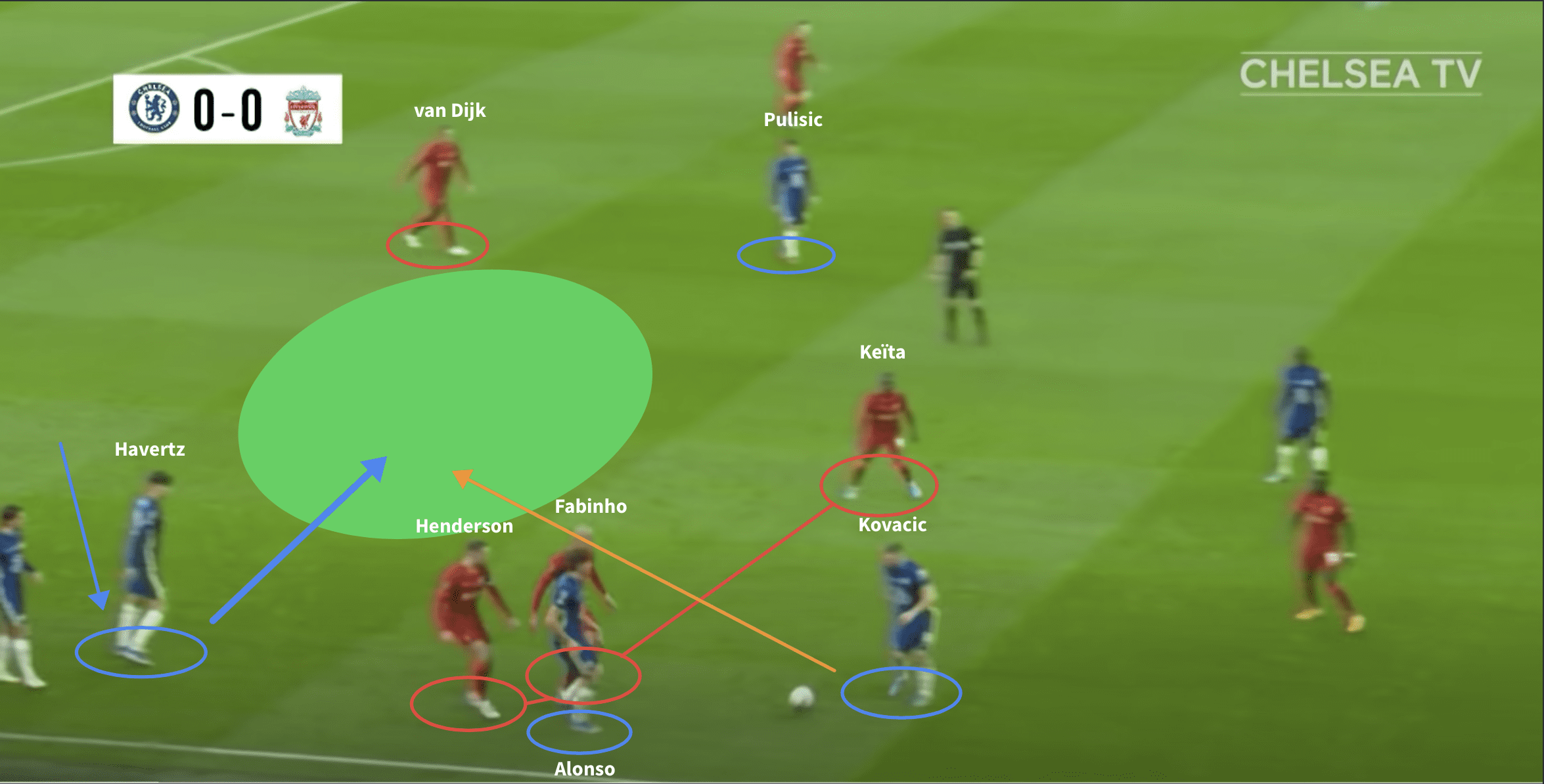
Here Havertz drops deep and wide to assist with overloading Liverpool numerically following a throw-in. Liverpool’s midfield trio of Fabinho, Henderson and Këita look to apply ball-orientated pressure, leaving a sizeable gap between the lines for Havertz to make a blind-side movement and expose.
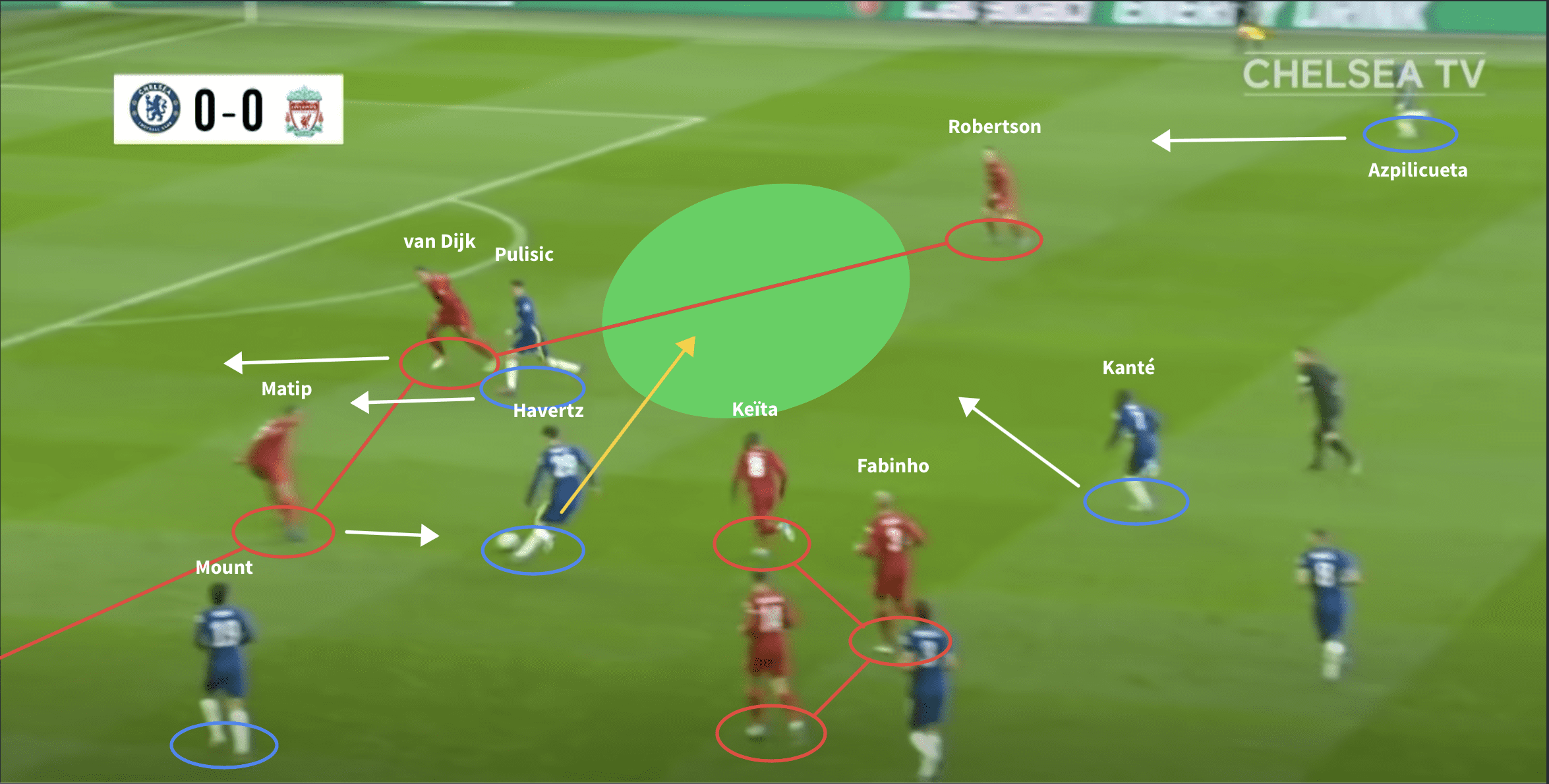
Havertz receives the ball and, significantly, can drive forward to achieve goal-side positioning on Këita. Matip is unsure whether to commit or hold his position, knowing that van Dijk could be isolated in his absence. A good diagonal run from Pulisic pulls van Dijk with him and ensures that Liverpool’s defensive block remains largely trapped within Chelsea’s left side, creating a generous gap between center-back and left-back.
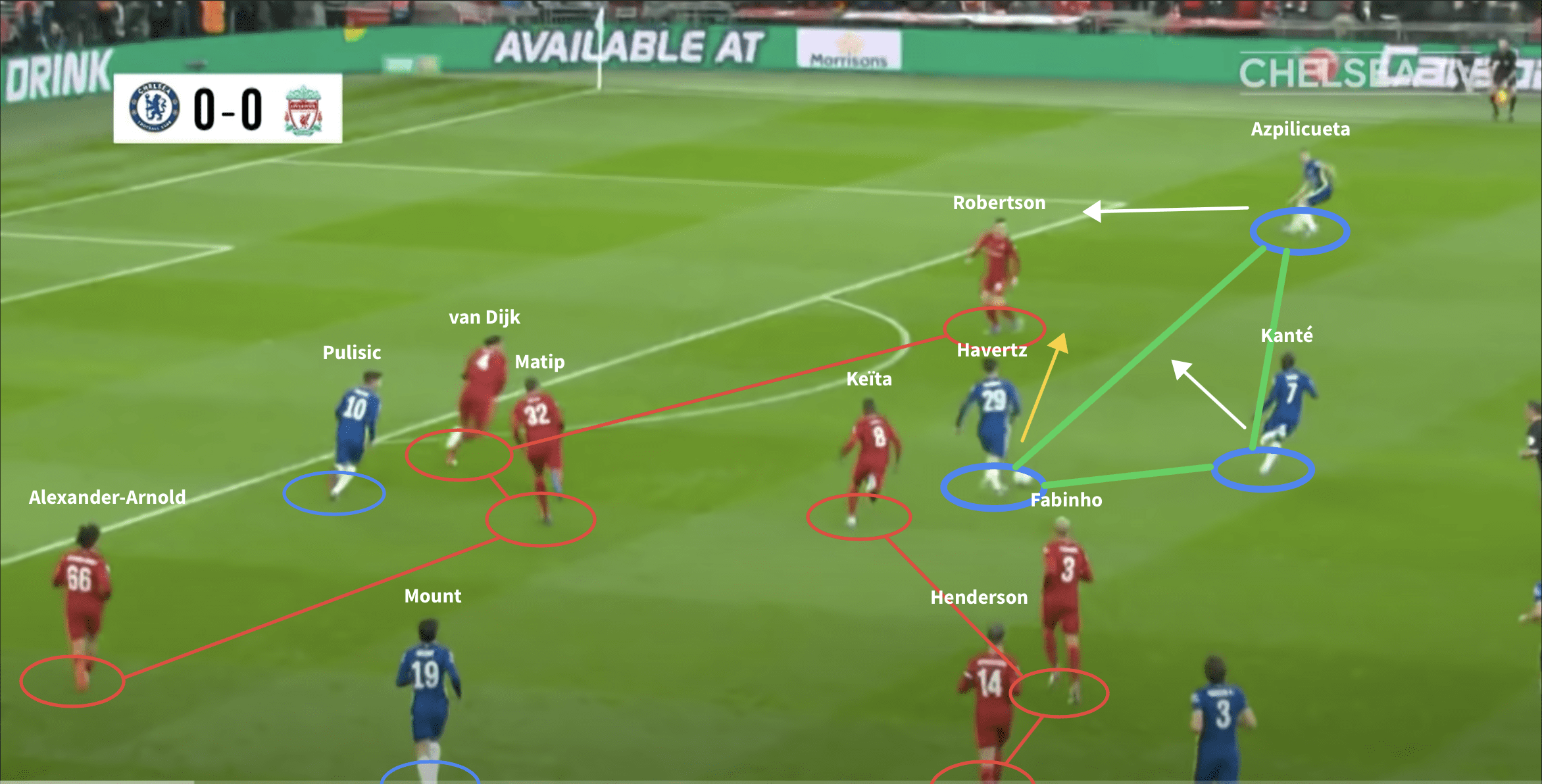
Havertz uses his effective and progressive dribbling ability to remain goal-side of Liverpool’s midfield. Pulisic’s run means van Dijk is severely out of position and an overload on the right is guaranteed, isolating Robertson in a potential 3v1 situation. The pass reaches Azpilicueta and Chelsea fashion a >0.5xG shot from the move.
The main takeaway from this passage of play is how Havertz here embodies a key tactical element in breaking down the opposition block and constructing the move in a 3-4-3 setup – specifically abandoning his perceived position up front and assisting in overloading the ball side to isolate the opposite flank.
By creating a situation which stretches the opposition’s defensive structure horizontally, this facilitates a fast and relatively simple switch of play to the other wing-back, who is occupying the widest vertical channel on the opposing side. Crucially, Havertz is even able to fulfil the switch of play himself by carrying the ball beyond the Liverpool midfield and into the final third. The opposition fullback is subsequently isolated and overwhelmed.
This situation arguably would not have transpired if the profile of starting striker did not embrace the importance of overloading in the sub-phases, rather choosing to stay high and central to battle the opposition center-backs. It is a testament to the accumulative functions a modern-thinking manager such as Tuchel demands from his number 9s.
Defensive contribution
Undoubtedly, one of the most important components for success in teams at the elite-level is their ability to press from the front. By mastering this, a team can effectively dictate opposition play and enjoy fruitful transitions from which to manufacture chances.
The criteria for this, however, equates to having the correct profile of attackers who can exhibit the tenacity and mobility to both press and counter press as a unit, whilst displaying tactical awareness to engage in pressing traps.
It goes without saying that Havertz possesses a more agile profile to his Belgian counterpart. But to quantify these elements, the figure below illustrates Havertz’s defensive metrics in the past 12 months:

These numbers demonstrate a willingness and relative ability to engage in defensive actions in the attacking third; Havertz’s average of 16.39 pressures per 90 places him in the top 33rd percentile of in Europe, whilst his tackling and interception quantities also impress.
By contrast, the figure below illustrates Romelu Lukaku’s defensive metrics in the same parameters:

The Belgian’s average of 9.91 pressures per 90 places him in the bottom 10th percentile of strikers in Europe, representing a far inferior defensive output than his teammate Havertz. Lukaku’s tackling and interception metrics also do not flatter him.
Without being able to press effectively, the team loses any element of front-foot impetus, which constitutes a key feature for managers who champion success through transitions. A poorly executed high press can also leave a team vulnerable in the midfield and defensive thirds, exemplified by Chelsea’s abject winter performances when Lukaku lead the line.
The defensive contribution Havertz as a false 9 offers this rejuvenated Chelsea side is significant; his work rate and pressing tendency helps provide compactness and balance to Chelsea’s first line of defence, rather than having to constantly compensate for a lack of off-the-ball intensity from Lukaku.
Conclusion
We are entering an era where the demands and roles of strikers are as excessive and diverse as ever.
The versatility and adaptability offered by players fulfilling ‘false 9’ function represents a more innovative option for teams who attempt to embrace high-pressing, positional rotation and a more intricate attacking approach in their game model.
Is the ‘traditional’ striker role dying in football? Of course it isn’t. But those calibre of players must be attentive to adaptation.
Rather than relying on the randomness of headers from speculative crosses aimed at the big, lumbering target men, most managers are preferring their sides to pick the extra pass and create clear sights of goal. It is the obligation of strikers now to assist in the preliminary stages of chance creation.
In revisiting Chelsea’s decision to break their transfer record on Romelu Lukaku, it seems viable that the Blues’ lust for a player with a high-conversion rate may have clouded their judgment of how the chances actually present themselves in the first place.
Lukaku, frankly, never embodied many of the in-possession and off-the-ball characteristics Tuchel demands from his forwards.
The current European Champions are however beginning to replicate last season’s level of performances following the welcomed and vindicated return of Havertz to the attack.





Comments